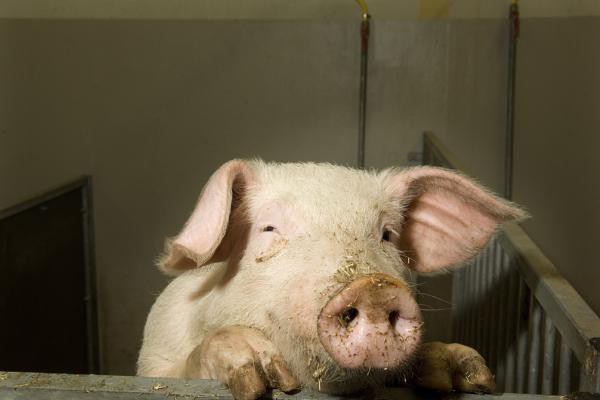Blood collection: practice makes perfect
5 years agoUsing a phantom pig to practice the vein puncture in pigs: soon this will be possible, thanks to the Utrecht 3Rs Stimulus Fund.
Ellen Meijer and her colleagues from the Faculty of Veterinary Medicine at Utrecht University will use the subsidy to develop a phantom pig (simUpig) with which veterinary students can practice this difficult part of practical education. The fund grants subsidies to employees of Utrecht University and the University Medical Center Utrecht, who have an idea to replace, reduce or refine the use of animals in their education or research.
What was your motivation to start this project and apply for a grant?
During the clinical phase of the veterinary education, all students must learn to collect blood in pigs. Currently, they can only practice this skill with living ill piglets that students collect from swine farms for diagnosis. Students generally experience blood sampling in these piglets as very difficult, which results in students taking 2 to 5 times longer than experienced veterinarians to collect a blood sample, thereby increasing the amount of discomfort of the piglets.
This explains the need to introduce a simulation model that enables students to master this skill and make fewer mistakes when dealing with a living animal. The call for proposals for the 3Rs Stimulus Fund was a perfect timing. It didn’t take long to write a proposal, since the requirements for the product we are aiming for are pretty straightforward. Moreover, by that time we had already found a company, Forma Fundo, that has experience in developing these types of models and was willing to help us with this phantom. The subsidy from the 3Rs Stimulus Fund was sufficient to have the phantom developed. The faculty and the company agreed that the model may be brought to the market after development. In exchange, the faculty receives a number of phantoms.
What does the model look like?
The phantom will be based on a 10 kilogram piglet. To make the model as realistic as possible, a full-body animal will be constructed. For this, one piglet needs to be killed to obtain the anatomical structures required for the model. Casts are made out of these structures, which are then used to create these parts with synthetic material. Deep-lying veins are placed in the neck, through which fake blood can flow.
Blood sampling in pigs is more difficult than in many other species. The vessel is deeply hidden in the muscles and fatty tissue in the neck. Students must therefore puncture with the needle, continue to apply suction and at the same time feel if they are on the right spot. That is very hard due to the lack of visual and tactile feedback. Our simUpig facilitates the practice of this procedure: being able to apply suction while at the same time searching for the right vessel. Forma Fundo has previously made similar models that are used in veterinary education in Utrecht, like a fake canine limb to practice a vein puncture, and a canine mouth to practice intubation procedures.
How does simUpig contribute to the 3Rs?
This phantom will mainly serve as a method for refinement. The desired outcome is that students learn to collect blood more quickly than before, thereby reducing the amount of discomfort in the animals. The fixation/restraint?, the search for the right vessel and the actual blood collection by an untrained student can take up to a few minutes. Often, the puncture has to be repeated several times. One can assume that this is not a comfortable experience for the piglets.
It remains important to still practice the procedure in a living animal after training with the model. A living pig will scream and try to move during fixation, which makes the experience even more challenging. With simUpig, students are taught the basics, and once they have mastered the procedure they will practice on a real piglet.
If simUpig is a success, it can be implemented in other fields of education as well. It can be used as additional training for those veterinarians who do not normally have to deal with pigs, but need the skill, for example, if an infectious disease breaks out and porcine blood samples need to be collected. The model could also be used in the species-specific laboratory animal science course for pigs, that is offered at the faculty of Veterinary Medicine as well.
What are the next steps?
After finalizing the legal paperwork, which took a lot more time than expected, we had to find a suitable pig, preferably without having to apply for a licence. The Animal Welfare Body has been very helpful, assisting us with the search for a pig that could serve not only our purpose, but could be used for teaching too. This February, we have euthanized the pig using a special procedure, thereby fixating the cadaver. It was transported to the company that will fabricate the model. Unfortunately, due to the Coronavirus restrictions, production of the model has for now stopped. Hopefully it can be resumed soon so we can finally put our model to use!
I’m looking forward to studying the effect the phantom has on the students. Objectively, we can investigate their improvement of skill by measuring the time it takes to take blood samples in living piglets, after training on the simUpig. Subjectively, we can ask students about their experience. I would be satisfied if students were actually faster, because the duration of the fixation and number of punctures have the greatest welfare impact on the pigs. From my point of view, I think that is the most important profit.
Ellen Meijer is a veterinarian. She works as a junior assistant professor at the Department of Farm Animal Health at the Faculty of Veterinary Medicine, Utrecht University. She contributes to the research programme Behaviour & Welfare.


